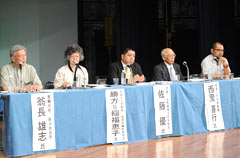Panelists discuss celebration of restoration of Japan’s sovereignty

In the evening on April 25, at the Ryukyu Shimpo Hall in the Izumizaki district of Naha, panelists discussed the issue of sovereignty for Okinawa.
April 26 2013 Ryukyu Shimpo
In the evening on April 25, a panel discussion was held on the topic of the Japanese government planning to hold a ceremony on April 28 to commemorate the anniversary of the restoration of Japanese sovereignty after the San Francisco Peace Treaty took effect in 1952. Held at the Ryukyu Shimpo Hall in the Izumizaki district of Naha, the discussion was sponsored by the Ryukyu Shimpo newspaper, Okinawa Television Broadcasting and Radio Okinawa
Five panelists discussed the significance of April 28, the date on which Okinawa was separated from Japan and placed under U.S. occupation, as well as the topic of sovereignty for Okinawa and Japan. About 620 people attended the panel discussion to gain a better understanding of these issues. The panelists also discussed whether or not Okinawa should seek to gain independence from Japan.
With regard to the Okinawan people’s opposition to the central government’s celebration of the date of restoration of Japan’s sovereignty, Naha Mayor Takeshi Onaga criticized Prime Minister Shinzo Abe, saying, “This has awoken a sleeping dog in Okinawa. In Abe’s mind, the issue of Okinawa was somewhere far off away in a corner.” With regard to the Abe administration becoming more conservative after the ceremony, Onaga said, “Rather than amending the Japanese constitution, revising the Japan-U.S. Status-of-Forces Agreement would allow Japan to regain its sovereignty.” Onaga emphasized the importance of everyone in Okinawa opposing the ceremony and establishing Okinawa’s sovereignty.
Writer Masaru Sato criticized the ceremony, saying, “The Japanese government’s celebration of the restoration date by referring to it representing the complete return of its sovereignty runs counter to its ongoing demands for the return of the Northern Territories. The central government decided to hold the ceremony without acknowledging that April 28 was actually the date that Okinawa was separated from Japan.” With regard to the Emperor Showa verbally requesting that the U.S. government continue the military occupation of Okinawa for an extended period of time, Sato said, “The people of the main islands of Japan avoid discussing the emperor but the Okinawan people do discuss this matter. They react differently to the emperor.”
Professor emeritus of the University of the Ryukyus, Kiko Nishizato, who specializes in modern history, criticized the ceremony, saying, “The U.S. government influences the Japanese government’s policies for relocation of Futenma Air Station within Okinawa, Japan’s participation in the Trans-Pacific Partnership and the reactivation of nuclear power plants. The ceremony is an attempt to cover up the reality of Japan’s subordination to the United States.”
Keiko Katsukata-Inafuku, a professor of Waseda University, who is originally from Okinawa, also criticized the ceremony, saying, “Although I consider that the Okinawan governor’s decision not to attend the ceremony is the right one, I think that the vice governor’s attendance does not show respect for Okinawan people’s feelings. I want the Okinawa Prefectural Government to indicate its intention to the Japanese government in some way.”
Yasukatsu Matsushima, a professor of Ryukoku University, who calls for Ryukyuan independence, said, “Militarization to enhance the islands defense could expose the Ryukyu Islands to the risk of being sacrificed by a mistaken national strategy. Ryukyu becoming completely independent is the best way to resolve the U.S. military base issues.”
(English translation by T&CT, Mark Ealey)
Previous Article:10,000 residents gather in protest rally against the anniversary of the restoration of Japanese sovereignty
Next Article:Government’s TPP task force promises to protect sugarcane on Minami Daito
[Similar Articles]
- Okinawan Intellectuals criticize Japanese government for political use of the Emperor
- [Editorial] Heads of all municipalities in Okinawa demand that the commemoration of the anniversary of the restoration of Japanese sovereignty be stopped
- Okinawa Prefectural Assembly opposes central government celebration of the date of restoration of Japan’s sovereignty
- [Editorial] Celebrating the date of restoration of Japan’s sovereignty is further humiliation for Okinawa Is Japan really an independent nation?
- Symposium to discuss the significance of Okinawa’s reversion to Japanese sovereignty held in Tokyo
 Webcam(Kokusai Street)
Webcam(Kokusai Street)


